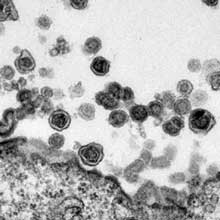
The past few months have not been easy for XMRV. The head of the Dutch study flatly stated that he believed the WPI’s samples had been contaminated. Dr. Shepard’s assessment was nothing if not gloomy and Dr. Vernon’s seemed to suggest that if the WPI’s results stood up that they probably applied only for a select few patients.
Meanwhile the work at the WPI appears to be continuing as before. Certainly from the outside we don’t any sense that the discovery is falling apart; Dr. Mikovits is as public as ever and is continuing to talk at conferences and before groups. We just learned, in fact, that she’ll publicly be expanding the WPI’s XMRV work into autism – hardly the behavior of a researcher who feels in doubt of her work.
So let’s look at what XMRV has going for it.
Antibody Test – Check? The spectre of contamination has been raised but you can’t apparently, drop a virus into a test tube of blood and have the immune system react to it. For one thing – there are no immune organs to produce the B-cells to produce the antibodies. So how could ME/CFS patients be producing an antibody to a virus they have never been exposed to?
One way is that the antibody test was not specific for XMRV which means it could have been reacting to another mouse virus. Until we get a better antibody test this must remain in the realm of possibility. We have to ask, though, what are the odds that patients would not contain antibodies to the virus they’d tested positive for but they would harbor antibodies to a similar virus. We also know that Cooperative Diagnostics looked for several streams of murine leukemia viruses in CFS patients and failed to find them. It also appears that the WPI is now (?) using Dr. Singh’s new antibody test which is more specific for XMRV in their current studies. Again, we don’t see any pullback from them on XMRV as we would expect if the antibody results were coming up negative.
Conclusion – its possible but not likely that the antibody tests gave a false positive result.
Ongoing Studies at the WPI – The studies the WPI is involved in provide an important internal check. WPI researchers should immediately know if contamination was present because it would be showing up in both patients and controls in equal numbers and that doesn’t seem to be happening. Indeed the fact that percentage positive rates have apparently not dropped markedly (check) and and healthy controls aren’t all testing positive for XMRV (check) can only suggest to the WPI (and us) that they’re on the mark.
Conclusion – – not conclusive but a strong positive for the WPI
The Virus in the Jar – The fact that they were able to watch a virus infect uninfected cells and then grow what looked like a gamma retrovirus in a ‘jar’ was another check. We did recently learn that gamma retroviruses are more likely to infect cell lines than other viruses but the WPI would, again, have to be exceedingly unlucky to have picked just the cell line that happen to be infected with a gamma retrovirus.
Conclusion – – not conclusive either but the odds are beginning to stack up (see below)
Calculating the Odds I – In order for XMRV not to work out it appears that several things are going to have to happen. ME/CFS patients are going to need to harbor other murine retroviruses (but not XMRV), a source of contamination is going to have to appear and disappear, and the WPI is going to have have used a cell line contaminated with gamma retroviruses. At some point you get to the point where it seems statistically either unlikely or very (ie very, very unlucky) that all these things would come to pass.
 Calculating the Odds II – On the other hand we have 3 negative studies, two of which reportedly featured top retrovirologists, who presumably know what they’re doing and would not want to risk professional embarrassment in such a high-profile study. We can throw in the Cooperative Diagnostics Lab work as well – since they do after all, specialize in developing diagnostic tests. We have to ask even if these are just validation studies, not replication studies, what are the odds that each of them made just the right type of ‘mistake’ that eliminated XMRV completely? They’re not good either. It’s a confounding situation either way.
Calculating the Odds II – On the other hand we have 3 negative studies, two of which reportedly featured top retrovirologists, who presumably know what they’re doing and would not want to risk professional embarrassment in such a high-profile study. We can throw in the Cooperative Diagnostics Lab work as well – since they do after all, specialize in developing diagnostic tests. We have to ask even if these are just validation studies, not replication studies, what are the odds that each of them made just the right type of ‘mistake’ that eliminated XMRV completely? They’re not good either. It’s a confounding situation either way.
Conclusion (conclusion?)– We don’t have a smoking gun either way. Nobody can prove contamination and there appears to be considerable evidence against it yet the WPI needs positve validation/replication studies to prove its finding and these have not been forthcoming yet. Does XMRV check out? The weight of the evidence still seems to me to be on the WPI’s side.
The One Test to Rule Them All– Several researchers have proposed that multiple labs do blinded tests of the same samples in order to clear up the confusion. The blinded element is the key. The DeFreitas retrovirus fell apart when it was subjected to the scrutiny of blinded tests. After her first postive internal blinded test she was unable to replicate the results in further public blinded tests. Neither was a lab that had consistently reported that it was distinguishing CFS patients from healthy controls using her test.
Yet a blinded test with several labs is probably the WPI’s best chance at turning this thing around quickly. If the WPI can accurately distinguish CFS patients and healthy controls using their test while other labs cannot it’s hard to believe that the research world won’t flock to them.
Doing blinded tests is tricky; for sure – with the high stakes involved they require a certain level of trust and a standard protocol and, of course, a high degree of coordination. During the DeFreitas era the CAA had the wherewithal to create a blinded test scheme. Its not clear that anyone’s doing that now.
